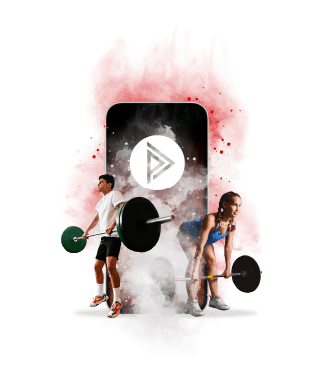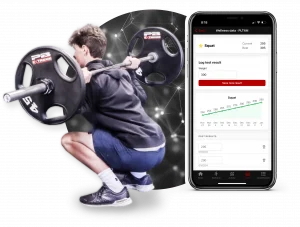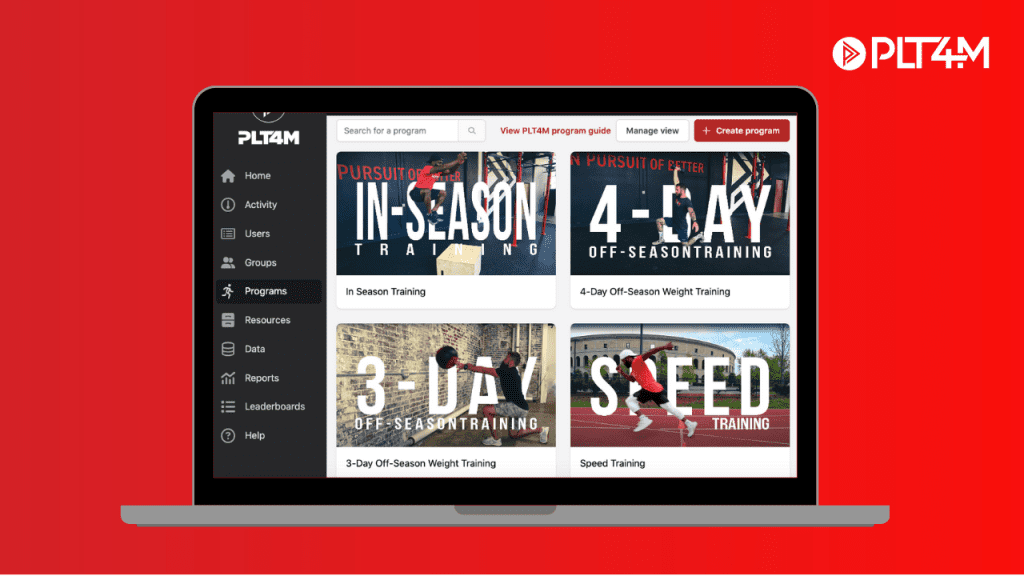A well-structured strength and conditioning program can enhance strength, power, speed, agility, capacity, and endurance while reducing the risk of injury. However, creating such a program can be daunting. This is where strength and conditioning templates come into play.
Strength and conditioning templates offer a structured approach to designing workouts that can be customized to fit goals and needs. These templates are time-savers and ensure that the workouts are balanced and comprehensive, covering all aspects of fitness and athletic development.
In this blog post, we’ll explore the importance of strength and conditioning templates, how they can maximize workout efficiency, and the key elements that make up a good template.
Evolution of Strength And Conditioning Templates
Strength and conditioning templates have been around for decades!
For years, coaches managed their program design with Excel templates. With Excel, coaches could write training programs with exercises, sets, reps, and percentages. From here, coaches could print Excel templates on standard “workout cards” that athletes would record weights and results.
While Excel templates worked, because they were not cloud-based, it meant printing was the only option. Because of this, many coaches transitioned to Google Sheets as technology evolved. Here, coaches could still print or allow athletes to log weights and workouts directly in a tab on Google Sheets.
And while these strength and conditioning template options worked, coaches spent countless hours logging data from training sessions. From these challenges came the rise of strength and conditioning software. Early iterations of strength training software were still merely a place for coaches to manage strength and conditioning templates.
But as software evolved, so came the addition of strength and conditioning apps that allowed athletes to access training plans on any digital device. As a result, coaches no longer had to spend time manually entering strength training data and workouts. This made workouts more efficient, effective, and engaging for athletes in a digital age.

Benefits of Strength and Conditioning Templates
Using strength and conditioning templates offers several benefits for individuals and coaches. Here are some advantages:
1. Structured Programming: Templates provide a structured and organized plan for strength and conditioning workouts. This helps individuals follow a systematic approach to their training, ensuring that different muscle groups and training domains are developed and addressed.
2. Time Efficiency: Templates save time by eliminating the need to design a new workout plan from scratch each time. Coaches can follow the pre-established template, making their training sessions more time-efficient. Or they can take a template and adjust and tweak the framework to fit specific needs or goals. (More on this later.)
3. Progress Tracking: With a template, tracking progress over time is more manageable. Users can record their performance in each workout, allowing them to see progress and identify areas for improvement.
4. Variety and Periodization: Templates often incorporate variety and periodization, ensuring that workouts change over time to prevent boredom and stagnation. This helps in avoiding plateaus and optimizing long-term progress.
5. Goal Specificity: Templates can be tailored to specific fitness goals, whether building strength, increasing endurance, or improving overall athletic performance. This goal-oriented approach helps individuals stay focused and motivated.
6. Consistency: Following a template promotes consistency in training. Consistency is critical for achieving fitness goals, and templates provide a roadmap that users can consistently follow.
7. Adaptability: Templates can be adapted to different fitness levels and preferences. Whether someone is a beginner or an advanced athlete, templates can be modified to suit individual needs and capabilities

Challenges of Finding Strength and Conditioning Templates
There is no shortage of strength and conditioning templates out there. As coaches search for the right strength and conditioning templates for their audience, it can be challenging to sift through the endless options, especially for young middle and high school athletes.
For example, there are endless workout templates for personal trainers and private clients. Many of these templates are designed for clients to complete at home or in a commercial gym setting. While these are great for everyday clients, they likely aren’t applicable for middle and high school students and athletes.
Another example are the strength and conditioning templates for elite athletes and sport-specific programming. “I want a strength training program for my (insert sport) athlete.” And while sport specific training has become widely popular with the rise of social media, using these templates in a school setting can present a wide range of challenges when managing large groups of diverse students and athletes (many of which are multi-sport athletes).
But what are the best templates for middle and high school students and athletes? Let’s look closer at strength and conditioning templates for schools, teams, and physical education classes.
Free E-Book
The Ultimate Guide To High School Strength and Conditioning
Learn how to navigate the many challenges of building and running effective workouts at the high school level

Strength and Conditioning Templates For Total Athletic Development
When choosing strength and conditioning templates for middle and high school athletes, using the lens of total athletic development is a great place to start. As we look to prepare student-athletes in the weight room for the various demands of competition, it is important to think about the complete picture.
At PLT4M, we subscribe to a long-term athletic development model that progresses students and athletes through a comprehensive training plan. This can be achieved through a fitness and strength progression.
At younger ages, strength and conditioning templates focus on foundational human movements like the squat, lunge, hinge, press, and pull. First, athletes develop these skills with bodyweight workouts before adding light external loading like med balls and dumbbells. All this is still considered strength work for a novice athlete in the weight room!
From here, the next stage of training allows athletes to learn more traditional weight room movements like the barbell back squat, bench press, deadlift, and more. Starting with empty bars and lighter weights, athletes can master good form and technique before jumping into more advanced strength training workouts.
After this progression, athletes are ready for a new program focusing on athletic development through strength, power, plyometrics, work capacity, and heavier loads. This, paired with speed work, agility work, core training, and more, allows athletes to prepare for the different sports they play. Let’s look at a popular program from the PLT4M library.
Example of PLT4M Off-Season Program
One of PLT4M’s most popular strength and conditioning templates is the 3 Day Off-Season program. This program is aimed at developoing the complete athlete through Strength, Power, Control, & Capacity work, all built into a 3-Day lifting schedule.
Over the course of 48 total sessions, two major training cycles will be employed, with pre-, mid-, and post-assessment of all the relevant performance markers listed below.
In each 24-session cycle, a major emphasis will be placed on building raw total-body strength through the powerlifts and their variations. Simultaneously, we will develop our rate of force production, or “Power”, through a progression of plyometrics and the “Clean” movement – utilizing all it’s “Power” variations, from the top down. Lastly, we will consistently build durability and work capacity through a blend of active stability/mobility work, hypertrophy training, accessory strength development, and metabolic conditioning.
Workout Format:
Each training session contains a brief guided warm up, stability and pre-hab work, plyometrics, max strength & power development (powerlifts and olympic weightlifting), and supplemental strength training (unilateral work, push/pull, etc).
Every other training session will also end with an intense, competitive “Pillar” workout with complete instruction.
Bonus Content: Check out Coach Bres from PLT4M break down the 5 keys to off-season strength training!
Customizing Training Programs With PLT4M
While PLT4M’s strength and conditioning templates can be used as is, coaches have complete flexibility and customization options.
Many coaches choose to use most of what PLT4M has built but tweak and adjust smaller pieces of the workouts because of time, interests, or space. But with a strength and conditioning template, coaches can save time and know they are getting programming from a trusted source.
Alternatively, coaches can also create their own strength and conditioning templates within PLT4M. Consider PLT4M a blank slate to create any workout program you want! You can manage everything from exercises, sets, reps, rest intervals, percentages, and weight loads.
Long story short, PLT4M gives you every possible option for managing a middle or high school strength and conditioning program.

Ready To Raise The Bar?
Our platform is the #1 choice for coaches and teachers looking to take their program to the next level. Learn how you can save time, improve results, and increase student engagement.
Key Takeaways on Strength and Conditioning Templates
Whether you are creating your own strength and conditioning templates or looking for ideas and resources to save you time throughout your week, PLT4M has you covered. With a full slate of workout templates and technology to customize, PLT4M is built to empower middle and high school weight rooms across the country.
With over 1,000 schools already using PLT4M, see how your school can take advantage of some of the best templates for middle and high school weight rooms. Reach out to learn more!
FAQ
What other programs does PLT4M have?
While we featured our 3-day off season program in this blog, PLT4M has a full library of different program options including things like Intro to Fitness, Intro to Strength Training, In-Season and Off-Season programs, speed, conditioning, mobility, flexibility, and more. PLT4M is a comprehensive strength and conditioning program!
Does PLT4M personalize workout programs for athletes?
Yes, PLT4M uses a perceived 1 rep max to personalize every weight, set, and rep for athletes. In addition, we use a feature called worksets that will adjust weights over time.
For example, if a student is tasked to complete 5 reps on their final set of the bench press, based on the number they complete there max will go up, down, or stay the same. Better yet, they will get the feedback directly on the PLT4M app when they complete the set.










